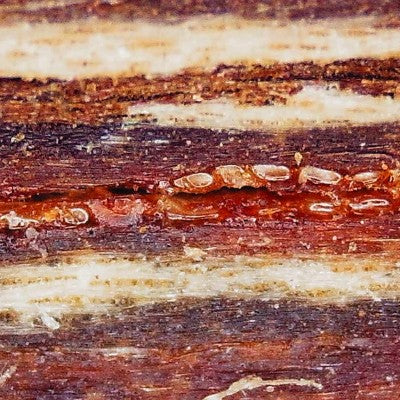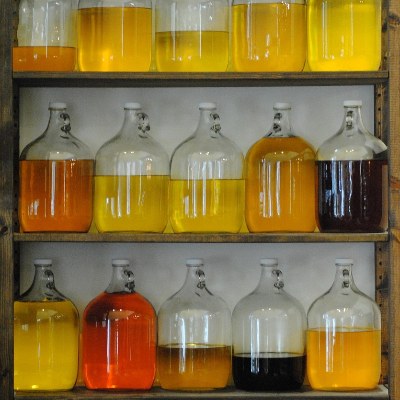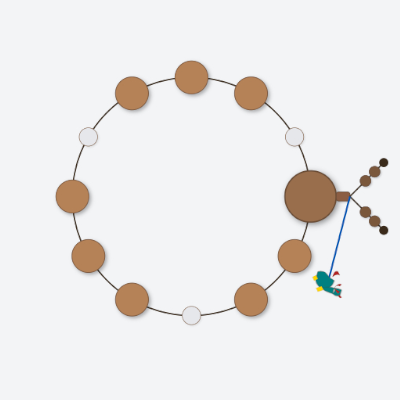
你认为野生沉香木更胜一筹吗?再想想——栽培沉香木与野生沉香木
十一月 22, 2024 1 读
我正在处理你的订单。嗡嗡嗡,我的手机震动了。是 Whatapp 打来的。
“你好,我是特伦特”
“野生沉香与栽培沉香有何不同?”
我正要解释,但顾客却继续说下去。
“哪一个更好?”
“价格为何相差这么多?”
因此我礼貌地告诉他,我会以书面形式答复他,因为我无法在 5 分钟的通话中完成答复。
这让我想起我过去曾遇到过很多类似的问题,所以我将在这个博客中回答这些问题。
什么是栽培沉香?
栽培沉香木是从种植园中受感染的沉香树上采摘的沉香木。
什么是诱导沉香?
诱导沉香是切割沉香的另一个名称。
诱导沉香木是使用先进技术“诱使”沉香树产生树脂而制成的。通过使用真菌诱导剂,科学家可以刺激树木产生沉香木,而无需依赖缓慢的自然过程。这种方法不仅可以保护野生树木,还可以提供这种宝贵资源的稳定供应。
沉香木是怎样栽培出来的?
整树沉香诱导技术已证明在栽培树中生产优质沉香方面非常有效。与传统技术相比,该方法可将产量提高 28 倍(刘等人,2013 年) 。
人工诱导有很多不同的方法,例如物理钻孔、化学和生物诱导剂,这些方法对于从栽培的沉香树中生产沉香木至关重要。这些方法解决了可持续性问题并提高了质量( Azren 等人,2019 年)。
什么是野生沉香?
野生沉香木是在自然条件下产生的,当沉香树或 Gyrinops 树受到伤口或感染时,木材中会形成树脂( Chen 等人,2017 年)。
但什么是自然条件呢?我觉得关键是“没有”人为的干预。
野生沉香是怎样炼成的?
真菌感染:当树木自然感染诸如Phaeoacremonium parasiticum等真菌时,它会触发心材中树脂的产生作为一种防御机制(Manohara,2013) 。
昆虫侵扰:某些昆虫及其幼虫会损害树木,导致树脂形成。例如,蚂蚁和蛀虫。
物理损害:树枝掉落、风暴或放牧动物造成的自然损伤会引发树脂积聚。
环境压力:干旱、大风或极端温度波动等条件可能会给树木带来压力,从而引发树脂的产生。
土壤和气候:东南亚等热带地区的特定土壤类型、湿度和温度支持树脂诱导因素的自然发生。这解释了为什么沉香木主要分布在东南亚(文莱、印度尼西亚、马来西亚、泰国、老挝、中国、越南)
猎人需要在野外识别这些树木才能砍伐它们。他们如何识别?
根据经验和外表。
任何有经验的供应商都能够快速识别野生沉香,但如果你问他们如何做到这一点,很遗憾他们很可能会告诉你。
科学家如何辨别野生沉香与栽培沉香?
| 方法 | 教科书定义 | 它是如何工作的? | 说明 |
|---|---|---|---|
|
采用 PCA 的高效液相色谱法 (HPLC) |
HPLC 根据样品中的化合物与色谱柱的相互作用来分离样品中的化合物,而 PCA(主成分分析)则通过分析数据模式来区分样品。 | 将液体样本通过一个柱子,收集数据,然后应用 PCA 来解释模式。 | 这就像使用尺子来测量饼干中的巧克力片,以判断它们是自制的还是商店购买的。 |
| 超高效液相色谱–电喷雾电离质谱 | UPLC–ESI-QTOF-MS 使用液相色谱和质谱法来识别复杂混合物中的化学特征和独特标记。 | 使用色谱和电离技术分离和检测分子成分。 | 这就像一个超级放大镜,可以发现饼干屑中的微小细节。 |
| DNA条形码 | DNA条形码通过分析基因序列来对生物体进行分类或确定生物材料的来源。 | 提取 DNA、对特定区域进行测序并将其与数据库进行比较。 | 想象一下,通过查看饼干食谱来找出哪家面包店制作的。 |
| 代谢组学和遗传标记 | 代谢组学研究化学指纹,而遗传标记则提供有关物种或样本来源的见解。 | 使用光谱法和遗传技术分析代谢物和遗传标记。 | 想象一下,通过找到饼干留下的微小指纹就可以知道它们来自哪里。 |
| 近红外光谱 (NIR) | NIR 使用红外光根据材料反射或吸收光的方式来分析材料的成分。 | 将红外光照射到样品上并分析反射信号以确定特性。 | 魔法手电筒照射饼干,看看它们如何发光并判断它们是真是假。 |
野生沉香比栽培沉香更好吗?
马、黄、傅、乔和李 (2023)证明,诱导沉香的化学成分与野生沉香相似。这些科学家进一步
1.化学成分:几乎一样!诱导沉香含有许多与野生沉香相同的有益化合物,包括倍半萜烯和色酮。这些成分是其药用和抗氧化特性的来源。虽然树脂含量略低,但其含量约为野生沉香的 83%——非常相似。
2. 强大的健康益处- 抗氧化能力:野生沉香和诱导沉香都能对抗体内有害的自由基。这些自由基会导致衰老、炎症和疾病。诱导沉香可以像野生沉香一样有效地中和 80-93% 的有害分子。
- 大脑健康:诱导沉香有助于抑制乙酰胆碱酯酶,这是一种与阿尔茨海默病有关的酶。这使得它有可能有助于改善记忆力和防止认知能力下降。
- 糖尿病管理:它还可以通过抑制α-葡萄糖苷酶(一种分解碳水化合物的酶)来减缓糖的吸收。这一特性使其成为控制血糖水平的绝佳选择。
为何诱导沉香如此重要?
1. 环境的救星野生沉香木非常稀有,因为只有一小部分沉香树会自然产生树脂。过度采伐已经危及这些树木,因此像人工沉香木这样的可持续替代品至关重要。通过人工制造沉香木,我们可以减轻野生种群的压力。
贸易和保护问题:野生沉香的过度开发和非法采伐使得人们不得不采取保护措施并根据《濒危野生动植物种国际贸易公约》等条约制定法规来控制其贸易(Espinoza 等人,2014 年) 。
2. 方便且价格实惠
野生沉香木价格极其昂贵,优质树脂每公斤价格高达 15,000 美元。而人工合成沉香木则是一种更实惠的替代品,同时仍具有许多相同的功效,因此更多人可以享用。
3. 用途广泛无论是用于香水、传统药物还是熏香,诱导沉香在历史上依赖野生沉香的行业中都具有广阔的前景。
诱导沉香(栽培沉香)背后的科学
制作诱导沉香木需要给树木接种真菌,以刺激树脂的产生。这些真菌会触发树木的防御机制,从而产生富含药用化合物的树脂。这个过程更快、更可控,并确保质量始终如一。
诱导沉香的未来
诱导沉香木表明科学和自然可以携手共进。通过提供可持续且有效的野生沉香木替代品,它为新药、更好的护肤品和奢华香水打开了大门,同时又不会损害我们的地球。
随着研究的深入,我们或许会看到更多利用诱导沉香改善我们的生活同时保护自然的方法。这是一项具有巨大潜力的小创新——对人类和环境都大有裨益。
沉香珠怎么样?野生的比较好吗?
珠子是有灵性的,简而言之,它们是不同的,有些分子只存在于野生沉香中,反之亦然。
我不能说野生沉香比栽培沉香好。到底好在哪方面呢?
野生沉香比栽培沉香更稀有,因为它们不可持续。一旦采收,可能需要数十年才能形成。
是的,野生沉香比较贵,因为比较难得到。
想想你上次吃野生稻或野生香蕉是什么时候。你见过或听说过它们吗?
至于香气,这非常个人化和主观化。很多人说野生沉香的香气更好。我的看法是也许,只是也许。你必须尝试才能感受到。
在 Grandawood,我们收藏了一系列优质的乌木油。其中许多都比野生油好。这些反馈不是来自我,而是来自我们的客户。
| 特征 | 野生沉香念珠 | 沉香念珠 |
|---|---|---|
| 质量 | 由于在不同压力条件下自然形成,因此香气和树脂成分非常复杂。不幸的是,人类只能检测到其中的几种芳香味。你需要几乎用鼻子贴住珠子才能闻到。因此人们认为野生沉香珠质量更好(树脂更多) | 使用真菌诱导等先进技术时,树脂质量相当。香气淡雅,但沉香树脂品质不错。最近的先进技术使培养的沉香树脂得到提升。一些珠子的沉香密度极佳。查看我们的 Kygarwood |
| 可用性 | 由于过度采伐和严格的贸易规定,其数量稀有且有限。 | 丰富,因为采用可持续方法种植。 |
| 环境影响 | 不可持续的采伐威胁着野生沉香树种。 | 由于重新造林和控制耕作,对环境友好。 |
| 成本 | 由于稀有和需求量大,价格非常昂贵。 | 相对来说价格便宜,方便。 |
| 可持续发展 | 可持续性有限,因为野生采伐会导致森林砍伐。 | 高度可持续,支持保护工作。 |
- Chen, Y., et al. (2017).使用 HPLC 结合 PCA 区分野生沉香和栽培沉香。发表于《亚洲植物科学与研究杂志》 。研究链接。
- Espinoza, E., 等人 (2014)。使用 DART-TOFMS 区分野生和栽培沉香 (Aquilaria spp.) 。发表于《Rapid Communications in Mass Spectrometry》 。研究链接。
- Huang, M. 等人 (2023)。真菌诱导沉香与野生沉香的品质相似性。发表于《植物科学前沿》 。研究链接。
- Tan, C., 等人 (2019)。沉香诱导:当前发展和未来展望。发表于《植物科学前沿》 。研究链接。
- Liu, Y. 等 (2013)。整树沉香诱导技术。发表于《林业研究杂志》。研究链接。
p/s 为了向你们展示我们培育的 GGG 沉香珠有多好,我有 2 张图片
1)手机摄像头

2)仔细观察它的树脂含量

最后的想法:
野生沉香木因其稀有性和复杂的香气而具有无可替代的魅力。要获得野生沉香木,需要承担许多风险(想象一下 30 天的丛林之旅),这是其价格高昂的主要原因。然而,人工种植的沉香木是一种可持续的创新解决方案,可以平衡质量、可获得性和环境责任。对于消费者来说,选择取决于个人喜好和优先事项,例如成本、可持续性和香气。
在Grandawood ,我们提供一系列乌木油和栽培沉香产品,我们的客户经常评价这些产品比野生油更优质。亲自尝试一下,感受其中的不同。
留个言
张贴前管理员会先审核您的留言



